Technique - Third-party SSL-JVC50 battery is not as bad as I thought...
Everybody who uses equipment with rechargeable batteries knows that no two batteries are the same. Especially when the equipment uses batteries with a specific shape, you usually are stuck with the ones supplied by the manufacturer which are often rather pricey.
Fortunately, there are batteries made by manufacturers that do exactly the same, but are definitely cheaper. At the same time, all kinds of bad stories surround these batteries concerning their capacity, misfit or other problems the original batteries don't have.
It's a bit of a bummer that it's very hard to tell the quality of your battery as a consumer. Besides bad cells the plastic of the case itself can be of bad quality as well. And where the original batteries usually are equipped with multiple safety-features, the third-party batteries can miss out on these. Only destructive investigation provides all the answers in the cases mentioned above.
A slightly doubtfull battery...
When I bought a 'new' (second hand) videocamera (JVC GY-HM200) back in May 2021, I got two batteries with it. When I got into a short talk about batteries with the owner and mentioned I was working on recelling my own V-mounts, she asked if I wanted the third battery as well. This battery, by 'Cameron Sino' as the sticker said, was refused by the charger and the camera didn't work with it as well.

I could take it with me at no extra charge and decided to take a look at it at home. These batteries at least have some extra connections to the outside world: this way the camera can give a very accurate reading of the remaining runtime and the charger most likely shows its charge-indicators.
On the outside it's a good battery by the way: the sticker in correct English about what you should and shouldn't do with it just oozes trustworthiness.
The listed capacity at 4400 mAh is in no way too good to be true and even the part-number, SSL-JVC50 is completely identical to that of the original battery by IDX. That they even went through the trouble to even mention a type of a JVC-camera in the type-designation (HM600) shows this is not just some cheap knock-off.
In April 2022, during a round of clean-up, the battery resurfaced and I decided to take a look at it right away.

Let's open it up!
This proved surprisingly easy with just a Stanley-knife. After just 3 cuts on one of the long sides, the casing clicked open on 3 of the 4 sides. With some wiggling with the blade, even the fourth glued connection gave way.
No way! This thing is beautifully made!
Honestly: this one is an excellent piece of design.
A good PCB, there's a foam shockabsorber between the cells and the casing and the casing itself isn't attached anywhere with either cells nor the PCB, which makes opening very easy and hassle-free.
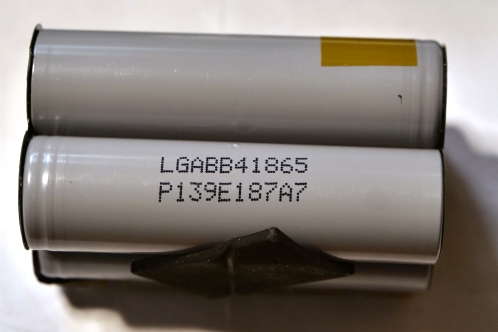 The cells are made by LG, type LGABB41865, clearly no B-choice!
The cells are made by LG, type LGABB41865, clearly no B-choice!
I quickly noticed a familiar prefix on the IC on the PCB... BQ... that wouldn't be?
So, after removing the paint that obscured the marking.... A BQ20Z45! There's a real gas-gauge in this battery!
And that's good, as both BE2Works and the software by Texas instruments can communicate with it via the EV2400!
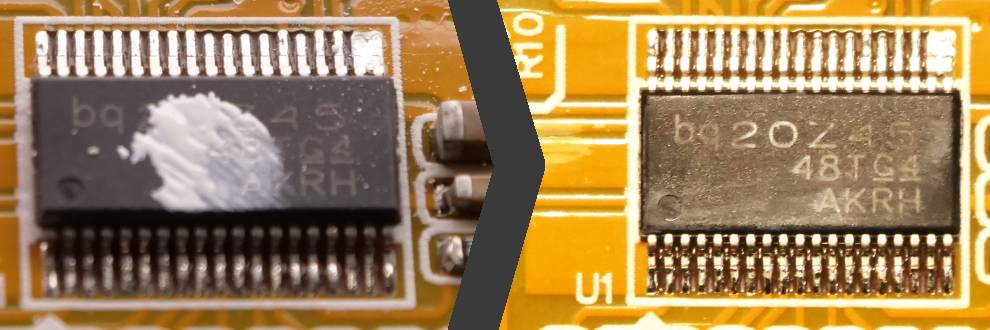
Cause?
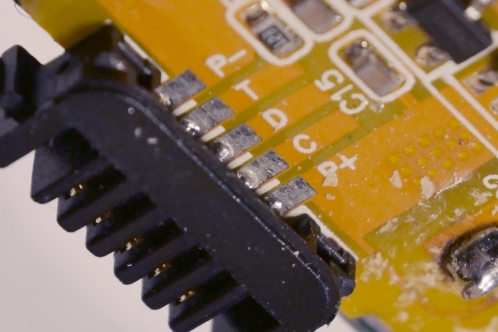 Even better: the PCB even mentions which of the pins is the data, clock and temperature-pin. As the PCB misses via's at the connector, I first thought the SMbus-pins of the IC had not been connected, but that seemed weird to me, as the IC itself was present (on the other hand, nothing surprises me anymore in Chinese stuff)
Even better: the PCB even mentions which of the pins is the data, clock and temperature-pin. As the PCB misses via's at the connector, I first thought the SMbus-pins of the IC had not been connected, but that seemed weird to me, as the IC itself was present (on the other hand, nothing surprises me anymore in Chinese stuff)
The multimeter quickly showed both SMbus-pins were connected, thus ruling out a connectivity-problem.
The problem can still be absent communication though. If authentication is being used or SMbus broadcasts are turned off in the IC, it won't work either.
Other possible cause: the battery has spent too long on the shelf, got deeply discharged and the IC noticed it, by completely disconnecting the cells forgood.
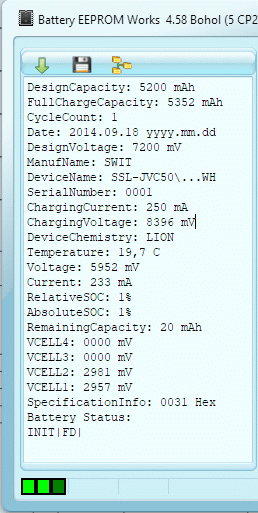 There's quite a chance that this is true as:
There's quite a chance that this is true as:
- The cells only measure about 2,5 Volts
- The cell-voltage hardly rises after short chargecycles (under 3 minutes)
- The charger shows an error after a few minutes, that almost immediately shows again after removal and re-insertion of the battery
- The battery can't be charged by myself
- There isn't any current flowing when I connect a small load
As this pack does not hold a logic fuse, this thus seems to be the most plausible explanation.
Be2works... and multiple surprises
With BE2Works I had already succesfully launched an attack at the BQ20Z65 chips in my V-mount batteries, so after soldering some wires to the header, connecting it to the USB-stick and plugging it into the computer I opened up the application.
And on read-out of the first data, the first surprise surfaced. This battery has been made by Swit! (Well, according to the electronic information that is). And Swit is a well-known company in AV-batteryland, but certainly not the manufacturer according to the sticker on the case.
Another oddity: The serial number. This is a collectors-item! The very first one ever!
I really found it weird there wasn't a single fault reported. The packvoltage had already increased significantly because of multiple attempts to charge it while taking read-outs of the chip, so taking the even lower cell-voltage into account it once had, I expected at least a Permanent Failure.
Haha! Surprise! No security present!
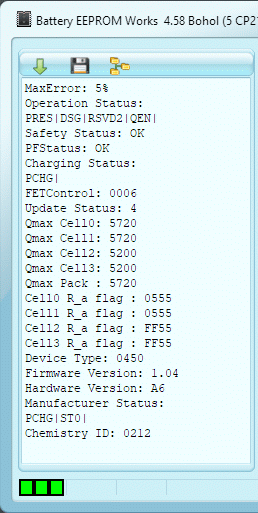 The biggest surprise was reading out the dataflash. By now, I know quite well how long this takes and when the LEDs on the USB-stick started flashing for a second time, I knew the dataflash could be read. And indeed, to my surprise, the screen showed that dataflash had been succesfully read. The chip has not been sealed!
The biggest surprise was reading out the dataflash. By now, I know quite well how long this takes and when the LEDs on the USB-stick started flashing for a second time, I knew the dataflash could be read. And indeed, to my surprise, the screen showed that dataflash had been succesfully read. The chip has not been sealed!
This clearly is a mishap.
Sealing, what? To prevent that a device that communicates with this IC can write to the dataflash (or writes bogus data because of some current-surge) ánd to prevent consumers like me to completely reset the battery should the cells get bad, the memory of this IC gets sealed after altering all the settings and completing the learning cycles.
Only the standard Smart Battery Status (SBS) data can then be read. Deeper access to the dataflash then requires giving in two 4-byte wide keys (UnsealKey and FullAccesKey), keys which are normally thought of by the manufacturer and thus aren't know to the general public. BE2Works can crack these keys quite quickly.
Sealing apparently was forgotten at the plant and thus I can see everything.
Things that stand out:
- MaxError: 5%. This should be 1%
- PFstatus OK: if there's one thing I did not expect, it's the absence of a Permanent Failure
- Qmax Cell2 and 3: I don't get why this shows a value when it's only a 2-cell battery
It's now a matter to find out what's wrong and if this battery will have any use at all.